If your goal is sculpted, powerful arms, cable arm exercises are one of the most effective ways to build both biceps and triceps fast. The cable machine provides constant tension, superior control, and multiple angle options — helping you achieve better muscle activation than traditional free weights.
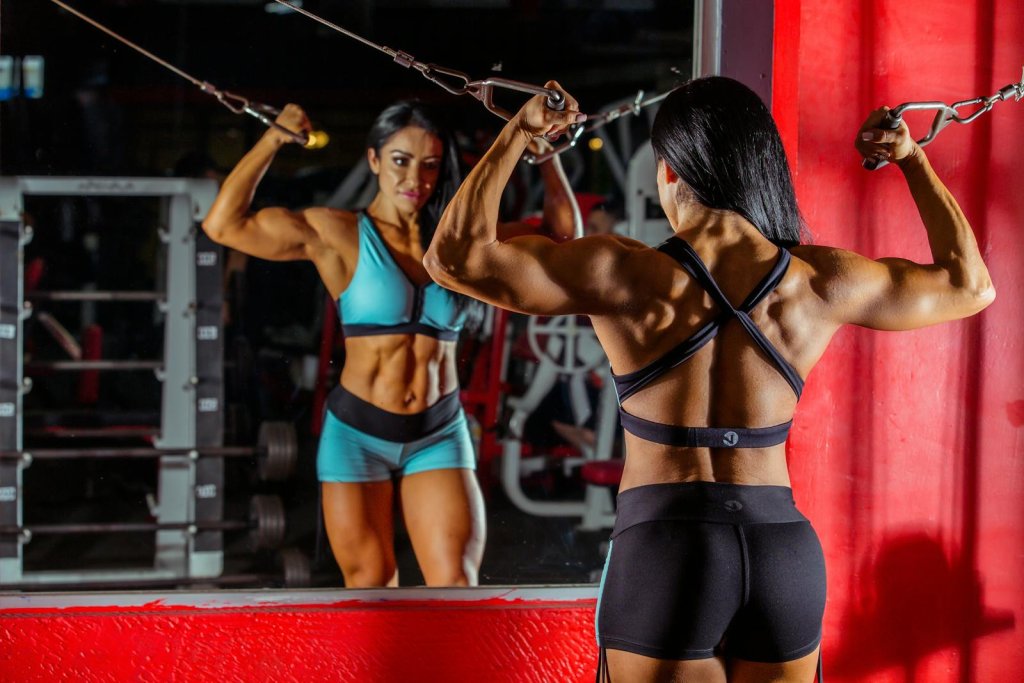
Understanding which cable exercises work best, how to perform them correctly, and how to program them ensures steady progress without injury.
Why Cable Arm Exercises Work
1. Constant Tension:
Cables keep your muscles working through the entire range of motion, boosting growth and endurance.
2. Adjustable Angles:
You can change pulley height and grips to target every head of your biceps and triceps.
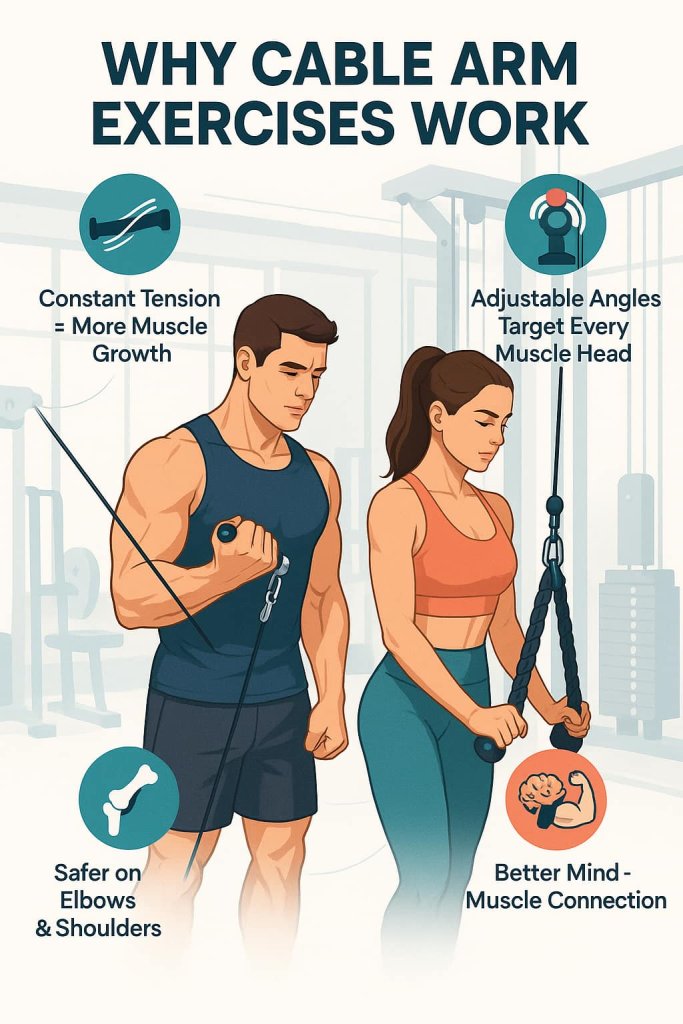
3. Joint-Friendly:
Smooth resistance reduces elbow and shoulder stress while keeping intensity high.
4. Better Mind–Muscle Connection:
Controlled movement helps you feel and activate the right muscles for balanced, defined arms.
How to Train Your Arms with Cables
Frequency
Train your arms 2 times per week with at least 48 hours between sessions.
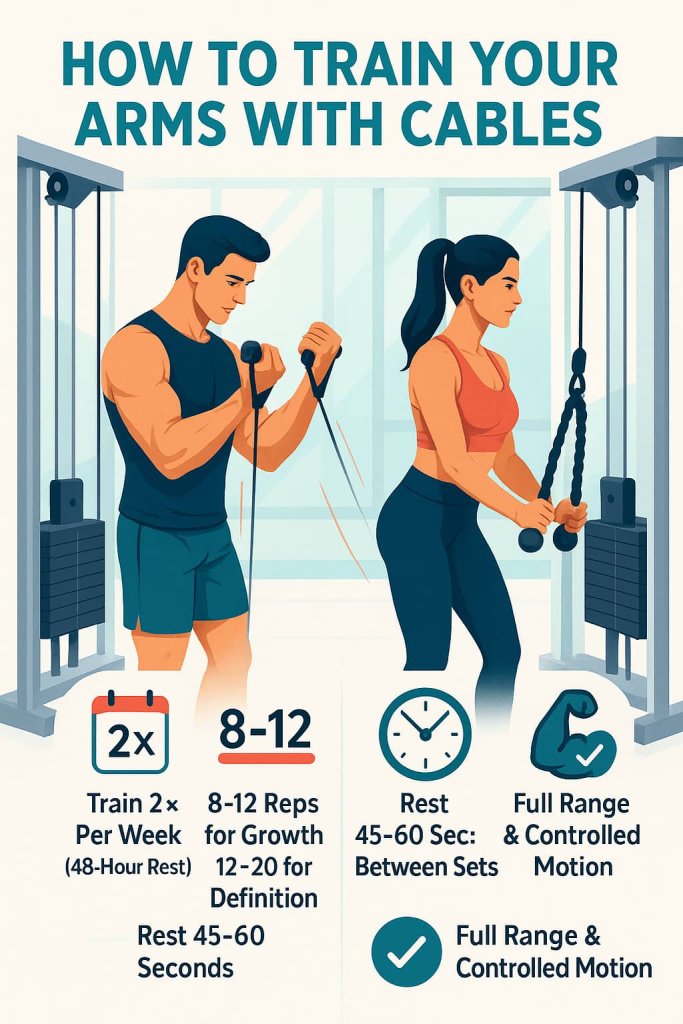
Reps and Sets
- For growth (hypertrophy): 8–12 reps
- For definition/endurance: 12–20 reps
- 3–4 sets per exercise
Pro Tips
- Keep elbows locked in place — don’t swing.
- Squeeze at the top of each rep for 1 second.
- Control the eccentric (lowering) phase slowly.
- Use full range of motion for best results.
- Rest 45–60 seconds between sets for a muscle pump.
17 Best Cable Arm Exercises
These 17 cable exercises target every part of your biceps and triceps for maximum growth, definition, and strength. Mix and match them to build a complete arm workout that delivers results fast.
Biceps Focus (8 Exercises)
1. Cable Bicep Curl (Straight Bar)
Why it works:
The cable bicep curl keeps your muscles under constant tension throughout the lift and lowering phase — something dumbbells can’t achieve because gravity only works vertically. This constant tension recruits both heads of the biceps and stimulates more muscle fiber activation. It’s an ideal exercise for building arm mass, improving mind-muscle connection, and enhancing overall arm symmetry.
Muscles worked:
Biceps brachii (short and long heads), brachialis, brachioradialis (forearm).
How to do it:
- Attach a straight bar handle to the lowest pulley.
- Stand tall with feet shoulder-width apart, chest up, and grip the bar with an underhand (supinated) grip.
- Keep your elbows pinned close to your sides.
- Curl the bar up toward your shoulders, exhaling as you contract your biceps.
- Pause for one second at the top, then slowly lower to starting position under control.
Trainer Tip:
Focus on keeping your upper arms still — avoid swinging or leaning back. Use a slow, deliberate motion and maintain tension throughout both directions of the movement.
2. Cable Hammer Curl (Rope Attachment)
Why it works:
The rope hammer curl shifts tension to the brachialis and brachioradialis, which lie beneath and beside the biceps. Strengthening these muscles adds width and thickness to your arms, giving them a more powerful, 3D appearance.
Muscles worked:
Brachialis, brachioradialis, biceps brachii.
How to do it:
- Attach a rope to the low pulley.
- Hold each end of the rope with a neutral grip (palms facing inward).
- Stand upright, elbows at your sides, and curl the rope toward your shoulders.
- At the top, slightly rotate wrists outward to emphasize contraction.
- Lower slowly and keep constant tension.
Trainer Tip:
Keep your wrists straight — don’t bend or twist excessively. The neutral grip is key for targeting the forearms and brachialis effectively.
3. Single-Arm Cable Curl
Why it works:
By training one arm at a time, you enhance muscular balance and allow for a deeper contraction. It also helps isolate the weaker arm to improve symmetry and control.
Muscles worked:
Biceps brachii (both heads), brachialis.
How to do it:
- Attach a single handle to the low pulley.
- Stand sideways to the machine with feet staggered.
- Grip the handle with your working arm, elbow tucked tight.
- Curl the handle toward your shoulder, focusing on keeping your wrist supinated.
- Lower with control and repeat.
Trainer Tip:
Perform the entire set on one side before switching. At the top of each curl, turn your pinky slightly outward — this enhances peak contraction.
4. Reverse-Grip Cable Curl
Why it works:
An overhand grip targets the often-neglected brachioradialis, developing forearm strength and density while adding detail to your biceps. It’s an excellent move for balanced arm development and grip power.
Muscles worked:
Brachioradialis, biceps brachii, forearm extensors.
How to do it:
- Attach an EZ bar or straight bar to the low pulley.
- Grab the bar with an overhand grip, hands shoulder-width apart.
- Keep elbows close to your torso and curl bar up until forearms are parallel to shoulders.
- Pause briefly, then lower under control.
Trainer Tip:
Use moderate weight — focus on smooth movement rather than heavy load. This is a detail exercise, not a power move.
5. High Cable Curl (Face-Away)
Why it works:
This exercise emphasizes the long head of the biceps, which contributes to the “bicep peak.” Facing away from the pulley provides a deep stretch at the bottom and intense contraction at the top — ideal for sculpting the upper biceps.
Muscles worked:
Long head of biceps brachii.
How to do it:
- Set each cable pulley at shoulder height.
- Stand facing away from the machine with one handle in each hand, arms stretched out slightly behind you.
- Curl both handles toward your temples or ears without moving elbows forward.
- Squeeze hard, then return slowly to stretch position.
Trainer Tip:
Keep elbows elevated slightly behind your torso to maximize long head engagement and muscle stretch.
6. Cable Drag Curl
Why it works:
A drag curl changes the bar path, keeping it close to your body and forcing your biceps to lift the load with minimal shoulder help. This isolates the short head and enhances bicep thickness near the shoulders.
Muscles worked:
Short head of biceps brachii, brachialis.
How to do it:
- Attach a straight bar to the low pulley.
- Hold it with an underhand grip, elbows at your sides.
- Pull the bar straight upward along your torso, keeping elbows behind your body.
- Squeeze at the top, then lower slowly.
Trainer Tip:
Visualize “dragging” the bar up your shirt rather than curling it outward — this keeps tension where it belongs.
7. Cable Preacher Curl (Kneeling or Supported)
Why it works:
By anchoring your upper arms on a bench or pad, you eliminate momentum and isolate the biceps completely. The cable’s continuous tension makes this more effective than a traditional preacher curl.
Muscles worked:
Biceps brachii, brachialis.
How to do it:
- Set the pulley to its lowest point.
- Kneel or position your upper arm against a bench angled toward the pulley.
- Curl the handle upward, pausing briefly at the top for a squeeze.
- Slowly return to the starting point.
Trainer Tip:
Keep your upper arm firmly pressed against the support pad throughout to prevent shoulder movement.
8. EZ-Bar Cable Curl
Why it works:
This variation reduces wrist strain while still offering full biceps activation. The curved handle allows a more natural grip, which lets you lift heavier loads with comfort.
Muscles worked:
Biceps brachii, brachialis, forearms.
How to do it:
- Attach an EZ-bar handle to the low pulley.
- Grip it with palms up and elbows close to your sides.
- Curl the bar toward your shoulders, squeeze, and lower slowly.
Trainer Tip:
Don’t rest at the bottom — keep slight bend in elbows to preserve continuous tension.
Triceps Focus (7 Exercises)
9. Cable Rope Tricep Pushdown
Why it works:
A classic mass builder that targets the lateral head — the part that gives your triceps that “horseshoe” shape. It’s excellent for both strength and tone.
Muscles worked:
Triceps brachii (lateral and long heads), forearms.
How to do it:
- Attach a rope handle to the high pulley.
- Stand upright, elbows close to your ribs, palms facing each other.
- Push the rope downward and slightly outward until your arms are fully extended.
- Slowly return to starting position.
Trainer Tip:
At the bottom, separate the rope ends and fully straighten arms — this maximizes the contraction in the lateral head.
10. Overhead Cable Tricep Extension
Why it works:
This move isolates the long head of the triceps, providing both stretch and power. The overhead position also improves shoulder mobility while building overall tricep size.
Muscles worked:
Triceps brachii (long head).
How to do it:
- Attach a rope to the low pulley.
- Face away from the machine and grasp the rope behind your head.
- With elbows pointed forward, extend your arms upward until fully straight.
- Lower slowly to feel the stretch behind your head.
Trainer Tip:
Don’t flare elbows outward — keep them close to your head to fully target the triceps.
11. Reverse-Grip Tricep Pushdown
Why it works:
Using an underhand grip recruits the medial head of the triceps, improving arm stability and elbow support.
Muscles worked:
Triceps brachii (medial head).
How to do it:
- Attach a straight bar to the high pulley.
- Grab it with an underhand (supinated) grip.
- Keep elbows fixed and push bar down until arms are fully straight.
- Slowly return to the start.
Trainer Tip:
This is a control-based movement — use moderate weight and focus on smooth execution.
12. Single-Arm Cable Kickback
Why it works:
Offers excellent isolation since each arm works independently. The cable tension keeps the triceps engaged even at full extension.
Muscles worked:
Triceps brachii (all heads).
How to do it:
- Attach a single handle to the low pulley.
- Bend slightly at the waist, keeping your upper arm parallel to the ground.
- Extend your forearm backward until your arm is straight.
- Lower under control and repeat.
Trainer Tip:
Go lighter — perfect form and full contraction are far more important than load here.
13. Cross-Body Cable Extension
Why it works:
This variation hits the triceps diagonally, engaging both the long and lateral heads through a unique range of motion. It enhances overall definition and symmetry.
Muscles worked:
Triceps brachii (long and lateral heads).
How to do it:
- Set a single handle at shoulder height.
- Stand sideways to the pulley and grab the handle with your opposite hand.
- Pull across your body until your arm is straight.
- Slowly return and repeat.
Trainer Tip:
Keep your elbow anchored close to your torso — the smaller your motion, the deeper your muscle engagement.
14. Rope Overhead Extension (Seated or Standing)
Why it works:
Provides an intense stretch on the long head and full contraction at the top, promoting thickness and strength.
Muscles worked:
Triceps brachii (long head).
How to do it:
- Sit or stand facing away from the pulley.
- Grip the rope behind your head.
- Extend your arms fully upward, then lower slowly behind your neck.
Trainer Tip:
Control the eccentric (lowering) phase — that’s where muscle growth happens.
15. Straight-Bar Pushdown
Why it works:
A straightforward compound isolation movement that allows heavier loads for tricep strength and mass.
Muscles worked:
Triceps brachii (lateral and medial heads).
How to do it:
- Attach a straight bar to the high pulley.
- Stand upright, elbows locked by your sides.
- Push the bar down until arms are fully extended, then slowly return.
Trainer Tip:
Slightly lean forward to stabilize but don’t move your elbows — all motion comes from the forearms.
Superset / Finisher Combos (2 Exercises)
16. Cable Arm Superset
Why it works:
Combining biceps and triceps exercises back-to-back maximizes muscle pump, nutrient delivery, and growth. Supersets increase intensity while saving time.
Muscles worked:
Biceps brachii, triceps brachii, brachialis, brachioradialis.
How to do it:
- Perform 12–15 rope pushdowns immediately followed by 12–15 hammer curls.
- Rest 60 seconds and repeat for 3–4 rounds.
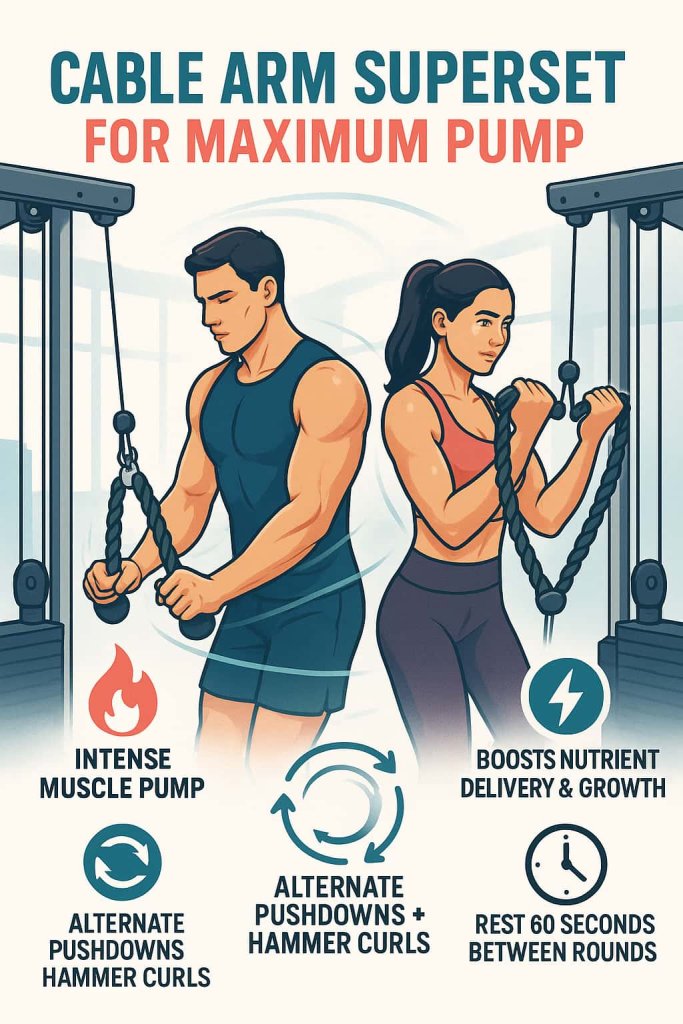
Trainer Tip:
Maintain strict tempo; prioritize the squeeze at both ends. You’ll feel massive arm engorgement from continuous blood flow.
17. 21’s Cable Arm Finisher
Why it works:
This hypertrophy technique divides the range of motion into three parts (bottom, top, and full), pushing your arms past fatigue. It’s a proven way to trigger new growth and pump volume into the muscles.
Muscles worked:
Biceps and triceps (all heads).
How to do it:
- Perform 7 bottom-half cable curls, 7 top-half curls, and 7 full curls.
- Immediately follow with 15 tricep pushdowns for a complete burnout.
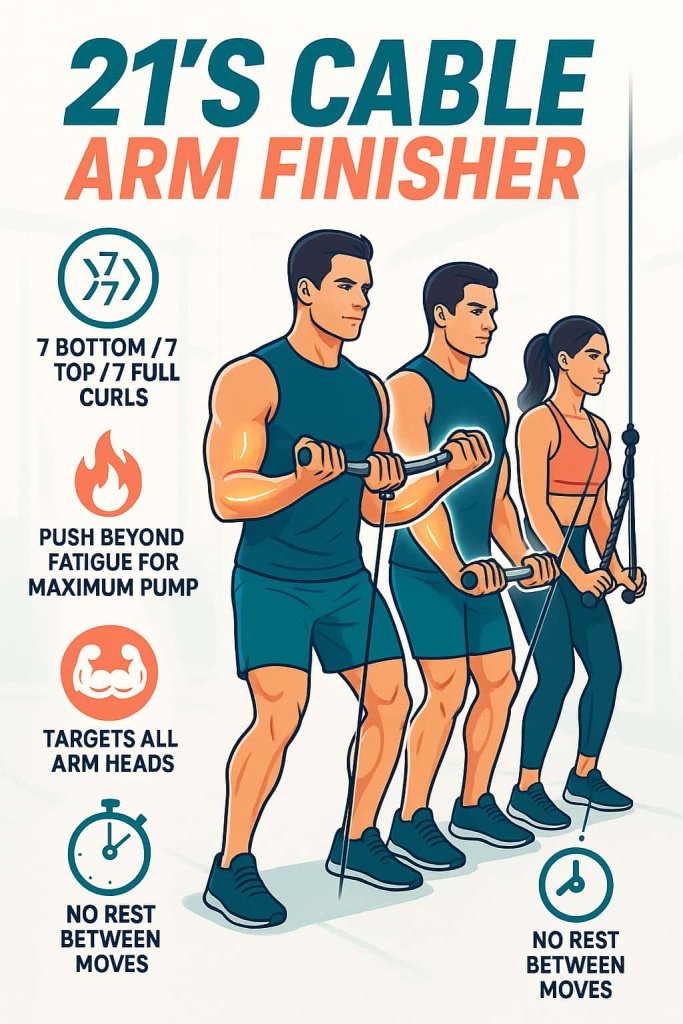
Trainer Tip:
Choose a lighter weight — control every inch of motion. The burn is what builds definition and vascularity.
Sample Cable Arm Workout
| Exercise | Sets | Reps | Focus |
|---|---|---|---|
| Rope Tricep Pushdown | 3 | 10–12 | Lateral head |
| Overhead Cable Extension | 3 | 10–12 | Long head |
| Straight-Bar Cable Curl | 3 | 8–12 | Biceps |
| Rope Hammer Curl | 3 | 12–15 | Forearms + brachialis |
| Superset: Kickback + Drag Curl | 3 rounds | 12 | Full arm pump |
Tip: Stretch your arms afterward to improve recovery and flexibility.
Common Mistakes to Avoid
- Using momentum or swinging your upper body
- Locking out elbows forcefully
- Skipping the stretch or contraction phases
- Overtraining — arms recover slower than you think
Safety and Recovery Tips
- Warm up 5–10 minutes before training to prepare muscles and joints.
- Keep your core tight, elbows steady, and move with control — no swinging or jerking.
- Use a 2-second up / 2-second down tempo for best results.
- Rest arms 48 hours between sessions for recovery.
- Stop if you feel sharp pain or joint discomfort.
Trainer Tip:
Smart training beats heavy lifting — focus on form, not ego.
FAQs
Q1: Are cables better than dumbbells for arms?
Cables offer constant tension and angle control — great for muscle growth. Dumbbells are better for stabilizer strength. Use both for best results.
Q2: How often should I train arms with cables?
Two sessions weekly with 48–72 hours rest is ideal.
Q3: Can beginners use cables?
Absolutely. Start light, focus on form, and gradually increase resistance.
Q4: What’s the best attachment for arm work?
Rope and straight bar attachments are most versatile for curls and pushdowns.
Q5: Can I build muscle using only cables?
Yes — with progressive overload, proper nutrition, and intensity, cables alone can build size and strength.
Q6: Are cable workouts safe for elbow pain?
Yes, because the resistance is smoother and joint stress is reduced — but stop if pain worsens.
Conclusion
Cable arm exercises combine science and simplicity — giving you consistent tension, adjustable resistance, and unmatched isolation. If your goal is bigger, more defined arms, cables belong in your routine.
Start today: pick 3–5 exercises from this list, perform them twice a week, and track your progress. Within a few weeks, you’ll notice stronger, fuller arms with better definition.
References
- ACSM Position Stand — Progression Models in Resistance Training
Guidelines on sets/reps, progression, frequency, and safety—perfect for your programming and YMYL sections.
Read on Medicine & Science in Sports & Exercise - Schoenfeld, B.J. — Mechanisms of Muscle Hypertrophy
Explains how mechanical tension, metabolic stress, and muscle damage drive growth—supports your “why cables work (constant tension)” claims.
Read on SpringerLink
